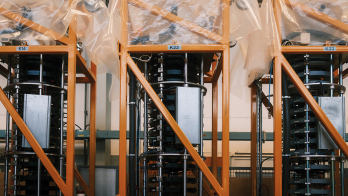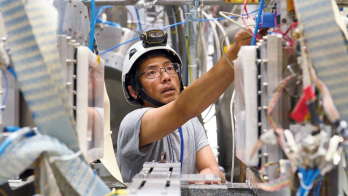Ursula Bassler reflects on the challenges in building the next major collider at CERN.

Twenty-five years. That is the time we have from now to ensure a smooth transition between the LHC and the next major collider at CERN. Twenty-five years to approve a project, find the necessary funding, solve administrative problems and define a governance model; to dig a tunnel, equip it with a cutting-edge accelerator, and design and build experiments at the limits of technology.
One of the most memorable moments of my time as president of the CERN Council came on 19 June 2020, when delegates from CERN’s Member States adopted a resolution updating the European strategy for particle physics. The implementation of the European strategy recommendations is now in full swing, based around two major topics for CERN’s long-term future: the Future Circular Collider (FCC) feasibility study with an organisational schema in place, and the elaboration of roadmaps for advanced accelerator and detector technologies. At the next strategy update towards the middle of the decade, we should be able to decide if the first phase of the FCC – an electron–positron collider operating at centre-of-mass energies from 91 GeV (the Z mass) to 365 GeV (above the tt production threshold) – can be built, paving the way for a hadron collider with an energy of at least 100 TeV in the same tunnel. By then, we should also have a clearer picture of the potential of novel accelerator technologies, such as muon colliders or plasma acceleration.
Besides the purely technical questions, many other challenges lie ahead. It will be indispensable to attract major interregional partners to CERN’s next large project. Together with the scientific impact, the socioeconomic benefits of skills and technologies built through large research infrastructures are increasingly recognised, which makes a new collider an appealing prospect for states to participate in. But what collaboration model can we elaborate together that is fair and efficient? How can we build bridges to other projects currently discussed, such as the ILC? The US recently started its own “Snowmass” strategy process, which may also impact the decisions ahead.
Neither the implementation of the technology roadmaps nor the FCC feasibility study, and far less its construction, can be carried out by CERN alone. Without a tight network of collaboration and exchanges it will not be possible to find the brains, the hands and the financial resources to ensure that CERN continues to thrive in the long term. The collaboration and support from laboratories and institutes in CERN’s Member and Associate Member States and beyond are crucial. Can we imagine new ways to enhance and to intensify the collaboration, to spread the quality and to share the savoir faire? Understanding where difficulties may lay merits continued efforts.

For projects that reach far into the century, we will need the curiosity, creativity and motivation of young people entering our field. Efforts such as the recent ECFA early-career researcher survey are salutary. But are there other means through which we can broaden the freedom and creativity for young scientists within our highly organised collaborations? If there are silver linings to the pandemic, one is surely the increased accessibility to scientific discourse for a greater range of young and diverse researchers that our adaptation to virtual meetings has demonstrated.
Societal acceptance will also be crucial in convincing local communities to accept the impact of a new, big project. Developing environmentally friendly technologies is one factor, especially if we can contribute with innovative solutions. In this context, the launch in September 2020 of CERN’s first public environment report (with a second report about to be published) is timely. CERN’s new education and outreach centre, the Science Gateway, will also significantly increase the number of people who can visit and be inspired by CERN.
For projects that reach far into the century, we will need the curiosity, creativity and motivation of young people entering
our field
The enormous amount of work that has taken place during Long Shutdown 2 lays the foundation for the HL-LHC later this decade. However, beyond ensuring the success of this flagship programme, and that of CERN’s large and diverse portfolio of non-collider experiments, we must clearly and carefully explain the case for continued exploration at the energy frontier. To other scientists: we all benefit from mutual exchange and stimulation. To teachers and educators: we can contribute to make science fascinating and help attract young people into STEM subjects. To society: we can help increase scientific literacy, which is crucial for democracies to distinguish sense from, well, nonsense.
Twenty-five years is not long. And no matter our individual roles at CERN, we each have our work cut out. Together, we need to stand behind this unique laboratory, be proud of its past achievements, and embrace the changes necessary to build its – and our – future.








